-
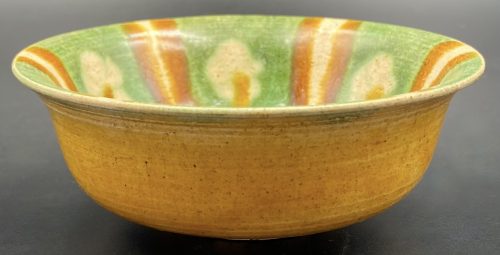 Small stoneware cup with rounded sides raising from a short foot to an inverted rim; glazed inside with a cream and brown six-petal design on a green background with cream and brown stylized flowers. Amber glaze outside, blue bottom, foot unglazed. Dia: 10 cm; H: 4 cm.
Small stoneware cup with rounded sides raising from a short foot to an inverted rim; glazed inside with a cream and brown six-petal design on a green background with cream and brown stylized flowers. Amber glaze outside, blue bottom, foot unglazed. Dia: 10 cm; H: 4 cm. -
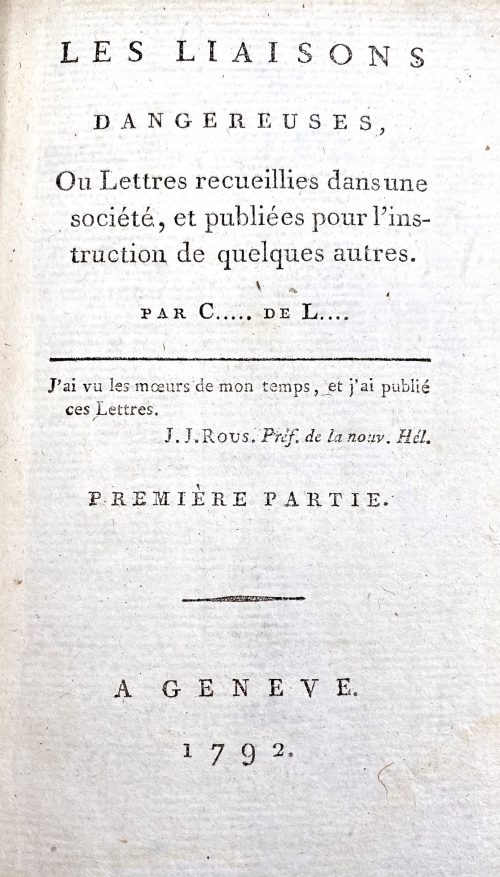 Four parts bound in two 18mo volumes (1-2 & 3-4), half polished brown calf, dot-ruled, flat spine with gilt bands and lettering, marbled boards, some plates with guard sheets, margins sparkled red. Title-page: LES LIAISONS | DANGEREUSES, | Ou Lettres recueillies dans une | société, et publiées pour l’ins- | truction de quelques autres. | par C….. de L… | — | J’ai vu les mœurs de mon temps, et j’ai publié | ces Lettres. | J. J. Rous. Préf. De la nouv. Hél. | PREMIÈRE PARTIE. | — | A GENEVE. | 1792. || Vol. 1: Pagination: ffep, blank, [2] – h.t., [i, ii] – t.p. part one, [iii] iv-xxij, [1] 2-245 [246] + 2 plates (p. 26 & p. 75); [1, 2] – h.t., [3, 4] – t.p. part two, [5] 6-233 [234], fep + 2 plates (p. 59 & p. 222). Collation: part 1: a12, A-M18 N5; part 2: A-M18 N9, plus four plates by various engravers after Le Barbier. Vol. 2: Pagination: ffep, blank, [1, 2] – h.t., [3, 4] – t.p. part three, [5] 6-225 [226] + 2 plates (p. 69 & p. 215); [1, 2] – h.t., [3, 4] – t.p. part four, [5] 6-250, fep + 2 plates (p. 25 & p. 201). Collation: part 3: A-M18 N5; part 4: A-N18 O5, plus four plates by various engravers after Le Barbier. Illustrations: After Le Barbier, engravers: Halbou (1), Simonet (1), N. Thomas (2), Dambrun (2), and Delignon (2). In the first illustration (vol. 1, part one, p. 26) Le Barbier signed “Le Barbier Jnv. 1794”, however, the edition was published (anonymously) in 1792. Cohen-De Ricci mentions an edition of 1794 (Paris: Maradan) and 1801 (Genéve) with the same plates. Lewine mentions a reprint of 1794 without naming the publisher. Catalogue raisonné: Cohen-De Ricci: 234-5, Ray: p. 79; Lewine: 109-10. Contributors: Choderlos de Laclos, Pierre Ambroise François (French, 1741 – 1803) – author. Le Barbier, Jean-Jacques-François (French, 1738 – 1826) – artist Engravers: Dambrun, Jean (French, 1741 – c. 1808) Delignon, Jean Louis (French, 1755 – 1804) Halbou, Louis Michel (1730 – 1809) Thomas, N. (French, c. 1750 – 1812) Simonet, Jean-Baptiste Blaise (French, 1742 – 1813)
Four parts bound in two 18mo volumes (1-2 & 3-4), half polished brown calf, dot-ruled, flat spine with gilt bands and lettering, marbled boards, some plates with guard sheets, margins sparkled red. Title-page: LES LIAISONS | DANGEREUSES, | Ou Lettres recueillies dans une | société, et publiées pour l’ins- | truction de quelques autres. | par C….. de L… | — | J’ai vu les mœurs de mon temps, et j’ai publié | ces Lettres. | J. J. Rous. Préf. De la nouv. Hél. | PREMIÈRE PARTIE. | — | A GENEVE. | 1792. || Vol. 1: Pagination: ffep, blank, [2] – h.t., [i, ii] – t.p. part one, [iii] iv-xxij, [1] 2-245 [246] + 2 plates (p. 26 & p. 75); [1, 2] – h.t., [3, 4] – t.p. part two, [5] 6-233 [234], fep + 2 plates (p. 59 & p. 222). Collation: part 1: a12, A-M18 N5; part 2: A-M18 N9, plus four plates by various engravers after Le Barbier. Vol. 2: Pagination: ffep, blank, [1, 2] – h.t., [3, 4] – t.p. part three, [5] 6-225 [226] + 2 plates (p. 69 & p. 215); [1, 2] – h.t., [3, 4] – t.p. part four, [5] 6-250, fep + 2 plates (p. 25 & p. 201). Collation: part 3: A-M18 N5; part 4: A-N18 O5, plus four plates by various engravers after Le Barbier. Illustrations: After Le Barbier, engravers: Halbou (1), Simonet (1), N. Thomas (2), Dambrun (2), and Delignon (2). In the first illustration (vol. 1, part one, p. 26) Le Barbier signed “Le Barbier Jnv. 1794”, however, the edition was published (anonymously) in 1792. Cohen-De Ricci mentions an edition of 1794 (Paris: Maradan) and 1801 (Genéve) with the same plates. Lewine mentions a reprint of 1794 without naming the publisher. Catalogue raisonné: Cohen-De Ricci: 234-5, Ray: p. 79; Lewine: 109-10. Contributors: Choderlos de Laclos, Pierre Ambroise François (French, 1741 – 1803) – author. Le Barbier, Jean-Jacques-François (French, 1738 – 1826) – artist Engravers: Dambrun, Jean (French, 1741 – c. 1808) Delignon, Jean Louis (French, 1755 – 1804) Halbou, Louis Michel (1730 – 1809) Thomas, N. (French, c. 1750 – 1812) Simonet, Jean-Baptiste Blaise (French, 1742 – 1813) -
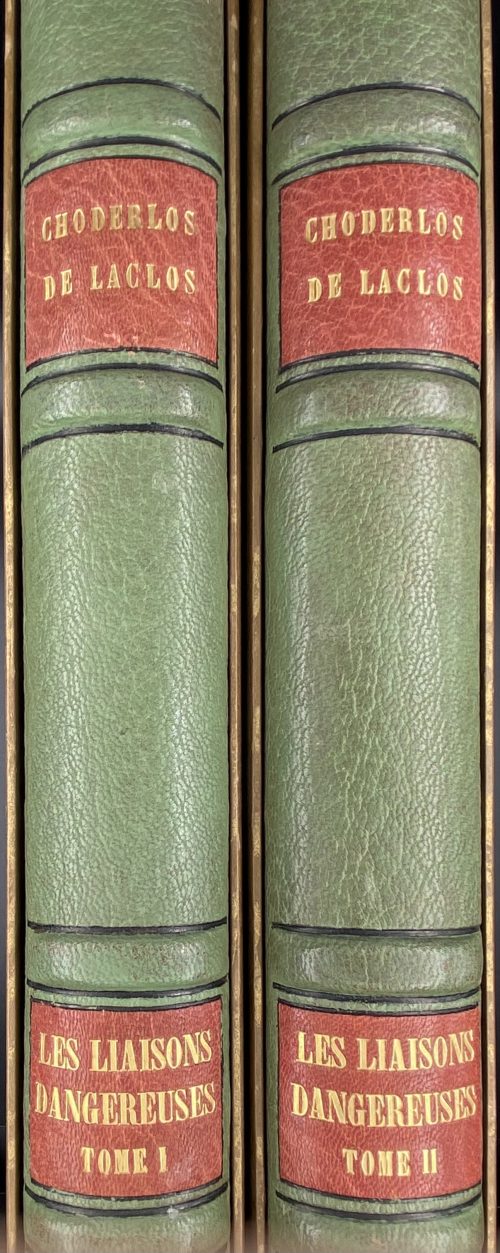 Description: Two volumes 34 x 26.5 cm each, each in a green/gilt marbled in a slipcase, bound in green morocco, spine with raised bands and two gilt-lettered brown labels, original wrappers bound in, marbled endpapers; printed on Montval watermarked wove paper, top margin gilt, outer and bottom margins untrimmed. Front wrapper (in oval red frame): CH. De LACLOS | LES | LIAISONS | DANGEREUSES | {fleuron} | TOME PREMIER (TOME SECOND) | — | CHEZ SYLVAIN SAUVAGE | 16 RUE CASSINI A PARIS | ANNO DOMINI | MCMXXX || Title-page (black and red): ~ CHODERLOS DE LACLOS ~ | LES | LIAISONS | DANGEREUSES | OU | LETTRES | RECUEILLIES DANS UNE SOCIETE ET | PUBLIEES POUR L’INSTRUCTION | DE QUELQUES AUTRES | {vignette} | TOME PREMIER (TOME SECOND) | AVEC DES FIGURES DE S. SAUVAGE | GRAVEES SUR CUIVRE AVEC LA COLLABORATION DE D.A.MAILLART | A PARIS EN L’AN GRACE | MCMXXX || Vol. 1: Collation: 2 blanks, 1 front wrapper, 1 blank/limitation, 1 h.t./frontis., 1 t.p., 3 advert., 1 d.t.p. première partie, 106 leaves, 1 blank, 1 back wrapper, 1 blank/spine, 1 blank; total within wrappers 114 leaves with woodcut fleurons and tailpieces, and 23 engraved and coloured plates, incl. frontispiece, full-page and in-text, some with tissue guards. Pagination: [14] [1] 2-211 [212] [2], ils. Vol. 2: 2 blanks, 1 front wrapper, 1 blank, 1 h.t./frontis., 1 t.p., 1 d.t.p., 109 leaves, 1 plate, 1 colophon, 1 back wrapper, 1 blank/spine, 1 blank; total within wrappers 115 leaves, with woodcut fleurons and tailpieces, and 25 engraved plates, engraved and coloured plates, incl. frontispiece, full-page and in-text, some with tissue guards. Pagination: [8] [1] 2-218 [4], ils. Limitation: Printed on September 29, 1930, 165 copies (1-165), the first four enriched with a suite of b/w plates and one original drawing; 10 copies for collaborators marked I-X. This is copy № 129. Contributors: Choderlos de Laclos, Pierre Ambroise François (French, 1741 – 1803) – author. Sylvain Sauvage [Félix Roy] (French, 1888 – 1948) – artist, publisher. Pierre Bouchet (text), Paul Haasen (plates) – printers.
Description: Two volumes 34 x 26.5 cm each, each in a green/gilt marbled in a slipcase, bound in green morocco, spine with raised bands and two gilt-lettered brown labels, original wrappers bound in, marbled endpapers; printed on Montval watermarked wove paper, top margin gilt, outer and bottom margins untrimmed. Front wrapper (in oval red frame): CH. De LACLOS | LES | LIAISONS | DANGEREUSES | {fleuron} | TOME PREMIER (TOME SECOND) | — | CHEZ SYLVAIN SAUVAGE | 16 RUE CASSINI A PARIS | ANNO DOMINI | MCMXXX || Title-page (black and red): ~ CHODERLOS DE LACLOS ~ | LES | LIAISONS | DANGEREUSES | OU | LETTRES | RECUEILLIES DANS UNE SOCIETE ET | PUBLIEES POUR L’INSTRUCTION | DE QUELQUES AUTRES | {vignette} | TOME PREMIER (TOME SECOND) | AVEC DES FIGURES DE S. SAUVAGE | GRAVEES SUR CUIVRE AVEC LA COLLABORATION DE D.A.MAILLART | A PARIS EN L’AN GRACE | MCMXXX || Vol. 1: Collation: 2 blanks, 1 front wrapper, 1 blank/limitation, 1 h.t./frontis., 1 t.p., 3 advert., 1 d.t.p. première partie, 106 leaves, 1 blank, 1 back wrapper, 1 blank/spine, 1 blank; total within wrappers 114 leaves with woodcut fleurons and tailpieces, and 23 engraved and coloured plates, incl. frontispiece, full-page and in-text, some with tissue guards. Pagination: [14] [1] 2-211 [212] [2], ils. Vol. 2: 2 blanks, 1 front wrapper, 1 blank, 1 h.t./frontis., 1 t.p., 1 d.t.p., 109 leaves, 1 plate, 1 colophon, 1 back wrapper, 1 blank/spine, 1 blank; total within wrappers 115 leaves, with woodcut fleurons and tailpieces, and 25 engraved plates, engraved and coloured plates, incl. frontispiece, full-page and in-text, some with tissue guards. Pagination: [8] [1] 2-218 [4], ils. Limitation: Printed on September 29, 1930, 165 copies (1-165), the first four enriched with a suite of b/w plates and one original drawing; 10 copies for collaborators marked I-X. This is copy № 129. Contributors: Choderlos de Laclos, Pierre Ambroise François (French, 1741 – 1803) – author. Sylvain Sauvage [Félix Roy] (French, 1888 – 1948) – artist, publisher. Pierre Bouchet (text), Paul Haasen (plates) – printers. -
 Woodblock print album of thirteen prints, ōban, nishiki-e. Artist: Chōkyōsai Eiri [鳥橋斎 栄里] (Japanese, fl. c. 1789 ~ 1801 ). Models of calligraphy (Fumi no kiyogaki), New Year 1801. This title is taken from Chris Uhlenbeck's Japanese Erotic Fantasies Sexual Imagery of the Edo Period. — Hotei Publishing, 2005, ISBN 90-74822-66-5):. A detailed description of the album can be found at The Complete Ukiyo-e Shunga №9 Eiri, 1996, ISBN 4-309-91019. Most of the edition is in Japanese, though Richard Lane writes a section in English: Eiri: Love-letters, Love Consummated: Fumi-no-kiyogaki. The article starts with the following statement: "Why all the fuss about Sharaku? Because he is so "mysterious"? No, not at all: because he is such a good artist. But Sharaku is not the only great yet enigmatic ukiyo-e artist and I propose to resurrect here one of his important contemporaries who has been all too long neglected: Chōkyōsai Eiri. As with many of the notable ukiyo-e masters, nothing is known of Eiri's biography. All we can say is what we learn from his extant prints and paintings: that he flourished during the second half of the Kansei Period [1789-1801]; and that he was a direct pupil of the great Eishi - who, being of eminent samurai stock, may well have attracted pupils of similar background." Another citation from Japanese Erotic Fantasies: "This album is one of the boldest sets of ōban-size shunga known, The first edition contains thirteen instead of the customary twelve designs". Here I present all thirteen prints, though the edition I bought in Kyoto in 2014 contained only twelve. The thirteenth print was purchased later in the United States (sheet №12).
Woodblock print album of thirteen prints, ōban, nishiki-e. Artist: Chōkyōsai Eiri [鳥橋斎 栄里] (Japanese, fl. c. 1789 ~ 1801 ). Models of calligraphy (Fumi no kiyogaki), New Year 1801. This title is taken from Chris Uhlenbeck's Japanese Erotic Fantasies Sexual Imagery of the Edo Period. — Hotei Publishing, 2005, ISBN 90-74822-66-5):. A detailed description of the album can be found at The Complete Ukiyo-e Shunga №9 Eiri, 1996, ISBN 4-309-91019. Most of the edition is in Japanese, though Richard Lane writes a section in English: Eiri: Love-letters, Love Consummated: Fumi-no-kiyogaki. The article starts with the following statement: "Why all the fuss about Sharaku? Because he is so "mysterious"? No, not at all: because he is such a good artist. But Sharaku is not the only great yet enigmatic ukiyo-e artist and I propose to resurrect here one of his important contemporaries who has been all too long neglected: Chōkyōsai Eiri. As with many of the notable ukiyo-e masters, nothing is known of Eiri's biography. All we can say is what we learn from his extant prints and paintings: that he flourished during the second half of the Kansei Period [1789-1801]; and that he was a direct pupil of the great Eishi - who, being of eminent samurai stock, may well have attracted pupils of similar background." Another citation from Japanese Erotic Fantasies: "This album is one of the boldest sets of ōban-size shunga known, The first edition contains thirteen instead of the customary twelve designs". Here I present all thirteen prints, though the edition I bought in Kyoto in 2014 contained only twelve. The thirteenth print was purchased later in the United States (sheet №12). №1: "...one of the most exotic scenes in all shunga. A Dutch kapitan is discovered coupling with a lovely Japanese courtesan, beside a large window opening upon a garden...".
№1: "...one of the most exotic scenes in all shunga. A Dutch kapitan is discovered coupling with a lovely Japanese courtesan, beside a large window opening upon a garden...".

 №2: "...a fair young harlot is seen masturbating with a grinding-pestle - a man watches intently from under bedding." [I have two specimens of this design; the one from album is more soiled but less faded].
№2: "...a fair young harlot is seen masturbating with a grinding-pestle - a man watches intently from under bedding." [I have two specimens of this design; the one from album is more soiled but less faded].
 №3: "...the artist has effectively contrasted the lovers by depicting the man's face as seen through the geisha's gauze skirt. [...] we are impressed more by strikingly elegant composition, the dramatic coloring, rather than feeling any great urge to participate in the energetic proceedings..."
№3: "...the artist has effectively contrasted the lovers by depicting the man's face as seen through the geisha's gauze skirt. [...] we are impressed more by strikingly elegant composition, the dramatic coloring, rather than feeling any great urge to participate in the energetic proceedings..."
 №4: "This scene is a most straightforward one, featuring the standard Missionary Position [capitalization by R. Lane].; but withal, the contrast of the young and naked, secret lover and the richly-clothed courtesan amid luxurious bedding..."
№4: "This scene is a most straightforward one, featuring the standard Missionary Position [capitalization by R. Lane].; but withal, the contrast of the young and naked, secret lover and the richly-clothed courtesan amid luxurious bedding..."
 №5: "In a striking lesbian scene (which has no equivalent in Utamaro, and is, incidentally, often omitted in later editions of this album), the girl at left prepares to receive the harikata (dildo) worn by the older girl at right (who holds a seashell containing lubricant)."
№5: "In a striking lesbian scene (which has no equivalent in Utamaro, and is, incidentally, often omitted in later editions of this album), the girl at left prepares to receive the harikata (dildo) worn by the older girl at right (who holds a seashell containing lubricant)."
 №6: "In the first appearance of a matronly heroine in this series, we find a widow - with shaven eyebrows and clipped hair - sporting with a handsome yound shop-clerk, mounting him with all her might."
№6: "In the first appearance of a matronly heroine in this series, we find a widow - with shaven eyebrows and clipped hair - sporting with a handsome yound shop-clerk, mounting him with all her might."

 №7: "... lady of samurai court: here, shown taking advantage of an official outing to temple and theatre, to rendezvous with a secret lover on a teahouse balcony." R. Lane considers this design the least successful in the series, especially in comparison with the same theme by Utamaro: "Utamaro female is almost ferocious in her lust for sexual gratification", which does not sound true to me. See Utamaro's sheet №5 from the album Utamakura (歌まくら, Poem of the Pillow) [courtesy The British Museum without permission]:
№7: "... lady of samurai court: here, shown taking advantage of an official outing to temple and theatre, to rendezvous with a secret lover on a teahouse balcony." R. Lane considers this design the least successful in the series, especially in comparison with the same theme by Utamaro: "Utamaro female is almost ferocious in her lust for sexual gratification", which does not sound true to me. See Utamaro's sheet №5 from the album Utamakura (歌まくら, Poem of the Pillow) [courtesy The British Museum without permission]:
 Then, as Richard Lane states, "we are flung suddenly to the bottom rung of Edo society":
Then, as Richard Lane states, "we are flung suddenly to the bottom rung of Edo society":
 №8: "Here we find a fair yotaka ('night-hawk', e.i. streetwalker) accommodating a lusty client in a lumberyard by the bank of the Sumida River".
№8: "Here we find a fair yotaka ('night-hawk', e.i. streetwalker) accommodating a lusty client in a lumberyard by the bank of the Sumida River".
 №9: '... a slightly plump harlot of the lower class receives a night visit from her lover, whose naked form she tries to cover with a cloak."
№9: '... a slightly plump harlot of the lower class receives a night visit from her lover, whose naked form she tries to cover with a cloak."
 №10: "...likely maidservant and lackey - are depicted in bath-room, their passions are all too obviously fired by steaming water."
№10: "...likely maidservant and lackey - are depicted in bath-room, their passions are all too obviously fired by steaming water."
 №11: "...this scene of courtesan and secret lover ranks high not only in Eiri's œuvre but also in the annals of the ukiyo-e genre itself. Both design and colouring are impeccable and, for this period, there is nothing even in the work of great Utamaro that really surpasses it." Again, a doubtful statement, however, this is Utamaro's design for the reader to judge:
№11: "...this scene of courtesan and secret lover ranks high not only in Eiri's œuvre but also in the annals of the ukiyo-e genre itself. Both design and colouring are impeccable and, for this period, there is nothing even in the work of great Utamaro that really surpasses it." Again, a doubtful statement, however, this is Utamaro's design for the reader to judge:
 The last design in my album is this:
The last design in my album is this:
 #13: In most reference books it goes under number 13, and we will assign this number to the sheet. "The final scene of the album features naked participants, probably samurai man and wife. The print is rather subdued in tone and colour, if not in the degree of the passion displayed..."
An additional sheet, acquired separately from a reputable dealer in New York, is usually listed as №12:
#13: In most reference books it goes under number 13, and we will assign this number to the sheet. "The final scene of the album features naked participants, probably samurai man and wife. The print is rather subdued in tone and colour, if not in the degree of the passion displayed..."
An additional sheet, acquired separately from a reputable dealer in New York, is usually listed as №12:
 №12: "One might think that Eiri has reached his peak with the preceding plate 11 - and indeed he has, in both esthetic and erotic terms. But the album is not yet finished, and the next scene lends a needed variety to the series, a slightly comic tableau featuring a middle-aged lackey attempting to forcibly seduce a servant girl of the same domicile". Utamaro's design, that inspired Eiri is here:
№12: "One might think that Eiri has reached his peak with the preceding plate 11 - and indeed he has, in both esthetic and erotic terms. But the album is not yet finished, and the next scene lends a needed variety to the series, a slightly comic tableau featuring a middle-aged lackey attempting to forcibly seduce a servant girl of the same domicile". Utamaro's design, that inspired Eiri is here:
 All descriptions are taken from Richard Lane's article at The Complete Ukiyo-e Shunga №9 Eiri, 1996. He concluded: "...Eiri's erotic series represents a major contribution to shunga art towards the close of ukiyo-e "Golden Age". In part inspired by Utamaro's classic album, this series withal constitutes a unified and original achievement, providing a cumulative effect of gracefully elegant yet glowing eroticism, which remains in the mind's eye long after the pictures themselves are far away."
I only would like to mention here that in several reference sources this album goes under name of Eisho; unfortunately, this mistake is reproduced at www.ukiyo-e.org, which miraculously shows exactly my print, but under the wrong name of the artist. The same mistake can be found at Shunga. The art of love in Japan. Tom and Mary Anne Evans. Paddington Press Ltd., 1975. ISBN 0-8467-0066-2; plates 6.74-6.77: Chōkyōsai Eishō, c. 1800. Even the British Museum edition of 2010 gives the same erroneous attribution: Chōkyōsai Eishō (1793-1801); they provide the following translation of title: "Clean Draft of a Letter" [see: Shunga. Erotic art in Japan. Rosina Buckland. The British Museum Press, 2010; pp. 110-112]. To the honour of the British Museum, I must admit that they have corrected themselves in Shunga. Sex and pleasure in Japanese art. Edited by Timothy Clark, et al. Hotei Publishing, 2013. Now, they say Chōkyōsai Eiri (worked c. 1790s-1801); they also provide a new title: "Neat Version of the Love Letter, or Pure Drawings of Female Beauty". I have already mentioned Richard Lane's version of title: "Love-letters, Love Consummated", and Chris Uhlenbeck's "Models of calligraphy". In poorly designed and printed Shunga. Erotic figures in Japanese art. Presented by Gabriele Mandel. Translated by Alison L'Eplattenier. Crescent Books, New York, 1983, the artist is named Shokyosai Eisho (beginning of the 19th century); title provided: "Models of Calligraphy". Correct attribution to Chōkyōsai Eiri also can be found at Poem of the pillow and other stories by Utamaro, Hokusai, Kuniyoshi and other artists of the floating world. Gian Carlo Calza in collaboration with Stefania Piotti. Phaidon Press, 2010; though the title is translated as "Clean Copy of Female Beauty".
All descriptions are taken from Richard Lane's article at The Complete Ukiyo-e Shunga №9 Eiri, 1996. He concluded: "...Eiri's erotic series represents a major contribution to shunga art towards the close of ukiyo-e "Golden Age". In part inspired by Utamaro's classic album, this series withal constitutes a unified and original achievement, providing a cumulative effect of gracefully elegant yet glowing eroticism, which remains in the mind's eye long after the pictures themselves are far away."
I only would like to mention here that in several reference sources this album goes under name of Eisho; unfortunately, this mistake is reproduced at www.ukiyo-e.org, which miraculously shows exactly my print, but under the wrong name of the artist. The same mistake can be found at Shunga. The art of love in Japan. Tom and Mary Anne Evans. Paddington Press Ltd., 1975. ISBN 0-8467-0066-2; plates 6.74-6.77: Chōkyōsai Eishō, c. 1800. Even the British Museum edition of 2010 gives the same erroneous attribution: Chōkyōsai Eishō (1793-1801); they provide the following translation of title: "Clean Draft of a Letter" [see: Shunga. Erotic art in Japan. Rosina Buckland. The British Museum Press, 2010; pp. 110-112]. To the honour of the British Museum, I must admit that they have corrected themselves in Shunga. Sex and pleasure in Japanese art. Edited by Timothy Clark, et al. Hotei Publishing, 2013. Now, they say Chōkyōsai Eiri (worked c. 1790s-1801); they also provide a new title: "Neat Version of the Love Letter, or Pure Drawings of Female Beauty". I have already mentioned Richard Lane's version of title: "Love-letters, Love Consummated", and Chris Uhlenbeck's "Models of calligraphy". In poorly designed and printed Shunga. Erotic figures in Japanese art. Presented by Gabriele Mandel. Translated by Alison L'Eplattenier. Crescent Books, New York, 1983, the artist is named Shokyosai Eisho (beginning of the 19th century); title provided: "Models of Calligraphy". Correct attribution to Chōkyōsai Eiri also can be found at Poem of the pillow and other stories by Utamaro, Hokusai, Kuniyoshi and other artists of the floating world. Gian Carlo Calza in collaboration with Stefania Piotti. Phaidon Press, 2010; though the title is translated as "Clean Copy of Female Beauty".
-

An iron tsuba of slightly vertically elongated circular form carved and pierced with a mass of ivy (tsuta) leaves and tendrils, details damascened with gold in nunome-zōgan technique. Hitsu-ana with raised rim.
Unsigned.
Chōshū school.Height: 72.0 mm; width: 69.0 mm; thickness: 4.7 mm; Weight: 92 g.
According to John W. Dower, "ivy bears fairly close resemblance to both maple leaf and grape leaf". However, I consider this tsuba decorated with ivy leaves for several reasons, such as the lack of racemations in the presence of tendrils. -
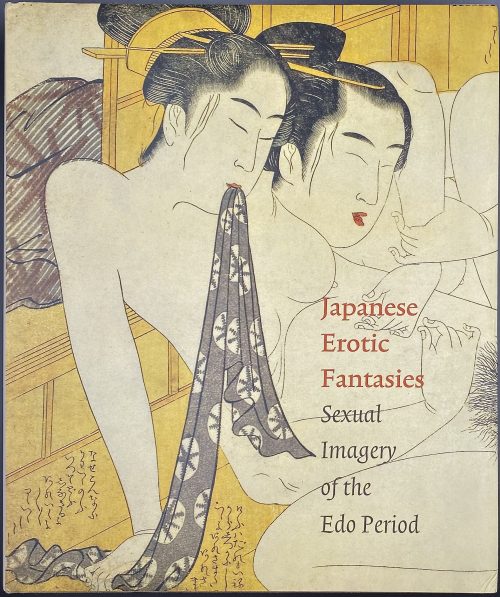 Hardcover volume, 30 x 25.5 cm, in brown cloth with yellow lettering to front cover and spine, in pictorial dust jacket, profusely illustrated in colour; pp.: [1-5] 6-256, total 128 leaves. Title-page (red and black): Japanese | Erotic | Fantasies | Sexual | Imagery | of the | Edo Period | Chris Uhlenbeck and | Margarita Winkel | with contributions by | Ellis Tinios | Cecilia Segawa Seigle | Oikawa Shigeru | Editor Amy Reigle Newland | {publisher’s device} Hotei Publishing, Amsterdam || Contents: Preface by Chris Uhlenbeck; Acknowledgements by Chris Uhlenbeck & Margarita Winkel; Editorial Notes; Shunga: the Issues by Chris Uhlenbeck; The Setting for shunga: the Yoshiwara by Cecilia Segawa Seigle; Erotic Books in the Floating World of Urban Life by Margarita Winkel; The Catalogue ('The Primitives'; The Age of Harunobu, Kiyonaga and Utamaro; The Nineteenth Century; The Meiji Period and Beyond); Appendix: Japanese characters for book, print and series titles; Glossary; Bibliography; General Index; Artists' Index. This publication coincides with the Exhibition "Desire of Spring. Erotic Fantasies in Edo Japan" from 22 January to 17 April 2005 in the Kunsthal Rotterdam (Impressum). Literaturverzeichnis: Seiten 247-250. Contributors: Chris Uhlenbeck Margarita Winkel Ellis Tinios Cecilia Segawa Seigle Oikawa Shigeru Amy Reigle Newland In this collection:
Hardcover volume, 30 x 25.5 cm, in brown cloth with yellow lettering to front cover and spine, in pictorial dust jacket, profusely illustrated in colour; pp.: [1-5] 6-256, total 128 leaves. Title-page (red and black): Japanese | Erotic | Fantasies | Sexual | Imagery | of the | Edo Period | Chris Uhlenbeck and | Margarita Winkel | with contributions by | Ellis Tinios | Cecilia Segawa Seigle | Oikawa Shigeru | Editor Amy Reigle Newland | {publisher’s device} Hotei Publishing, Amsterdam || Contents: Preface by Chris Uhlenbeck; Acknowledgements by Chris Uhlenbeck & Margarita Winkel; Editorial Notes; Shunga: the Issues by Chris Uhlenbeck; The Setting for shunga: the Yoshiwara by Cecilia Segawa Seigle; Erotic Books in the Floating World of Urban Life by Margarita Winkel; The Catalogue ('The Primitives'; The Age of Harunobu, Kiyonaga and Utamaro; The Nineteenth Century; The Meiji Period and Beyond); Appendix: Japanese characters for book, print and series titles; Glossary; Bibliography; General Index; Artists' Index. This publication coincides with the Exhibition "Desire of Spring. Erotic Fantasies in Edo Japan" from 22 January to 17 April 2005 in the Kunsthal Rotterdam (Impressum). Literaturverzeichnis: Seiten 247-250. Contributors: Chris Uhlenbeck Margarita Winkel Ellis Tinios Cecilia Segawa Seigle Oikawa Shigeru Amy Reigle Newland In this collection: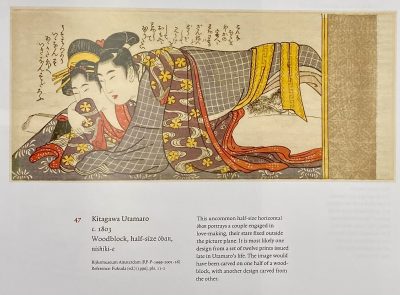
SVJP-0188.2015: Kitagawa Utamaro. Series of horizontal o-hosoban shunga prints, c. 1803.

SVJP-0034.2014: Chōkyōsai Eiri. Neat version of a love letter (Fumi no kiyogaki), 1801.
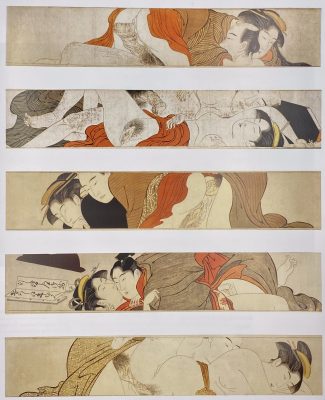
SVJP-0041.2013: Torii Kiyonaga. Handscroll for the sleeve (Sode no maki), c. 1785.
-
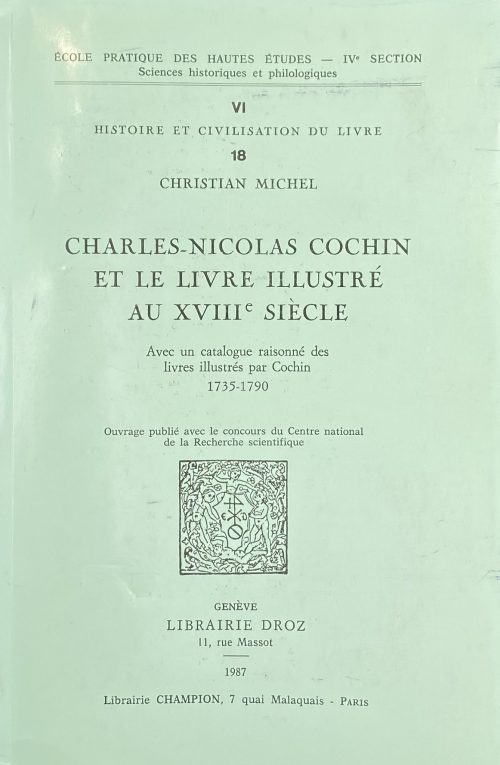 Description: 24.4 x 15.9 cm, softcover in-8vo, light-green publisher's wrappers, lettered in black to both covers and and spine; bookplate pasted to verso of the front wrapper: “LE GÉNIE DE LA GRAVURE | CONSOLE LE GÉNIE DU DESSIN | {vignette} | BIBLIOTHÈQUE DE CLAUDETTE HOULD || Title-page: ÉCOLE PRATIQUE DES HAUTES ÉTUDES — IVe SECTION | Sciences historiques et philologiques | — | VI | HISTOIRE ET CIVILISATION DU LIVRE | 18 | CHRISTIAN MICHEL | CHARLES-NICOLAS COCHIN | ET LE LIVRE ILLUSTRÉ | AU XVIIIe SIÈCLE | Avec un catalogue raisonné des | livres illustrés par Cochin | 1735-1790 | Ouvrage publié avec le concours du Centre national | de la Recherche scientifique | {device} | GENÈVE | LIBRAIRIE DROZ | 11, rue Massot | 1987 ||; front wrapper also has in the bottom: Librairie CHAMPION, 7 quai Malaquais – Paris || Collation: 8vo; [1]-258, 26 leaves of plates (fig. 1-169) extraneous to collation, 26+[27]14 288; plates: unpaginated photo reproduction of Cochin’s 169 drawings and engravings; quire 27 unsigned, together with quire 26 makes 14 leaves. Pagination: [i-vii] viii-x, [1] 2-431 [423 colophon] [2 blank], 26 leaves of plates. Provenance: Claudette Hould, Montréal, Quebec, Canada, spécialiste d’histoire de l’art français. Ref.: British Museum. Publisher: Droz Charles-Nicolas Cochin (French, 1715 – 1790) See Cochin's illustrated books in this collection: LIB-2941.2021, LIB-2766.2021; LIB-2640.2021; LIB-2529.2020.
Description: 24.4 x 15.9 cm, softcover in-8vo, light-green publisher's wrappers, lettered in black to both covers and and spine; bookplate pasted to verso of the front wrapper: “LE GÉNIE DE LA GRAVURE | CONSOLE LE GÉNIE DU DESSIN | {vignette} | BIBLIOTHÈQUE DE CLAUDETTE HOULD || Title-page: ÉCOLE PRATIQUE DES HAUTES ÉTUDES — IVe SECTION | Sciences historiques et philologiques | — | VI | HISTOIRE ET CIVILISATION DU LIVRE | 18 | CHRISTIAN MICHEL | CHARLES-NICOLAS COCHIN | ET LE LIVRE ILLUSTRÉ | AU XVIIIe SIÈCLE | Avec un catalogue raisonné des | livres illustrés par Cochin | 1735-1790 | Ouvrage publié avec le concours du Centre national | de la Recherche scientifique | {device} | GENÈVE | LIBRAIRIE DROZ | 11, rue Massot | 1987 ||; front wrapper also has in the bottom: Librairie CHAMPION, 7 quai Malaquais – Paris || Collation: 8vo; [1]-258, 26 leaves of plates (fig. 1-169) extraneous to collation, 26+[27]14 288; plates: unpaginated photo reproduction of Cochin’s 169 drawings and engravings; quire 27 unsigned, together with quire 26 makes 14 leaves. Pagination: [i-vii] viii-x, [1] 2-431 [423 colophon] [2 blank], 26 leaves of plates. Provenance: Claudette Hould, Montréal, Quebec, Canada, spécialiste d’histoire de l’art français. Ref.: British Museum. Publisher: Droz Charles-Nicolas Cochin (French, 1715 – 1790) See Cochin's illustrated books in this collection: LIB-2941.2021, LIB-2766.2021; LIB-2640.2021; LIB-2529.2020. -
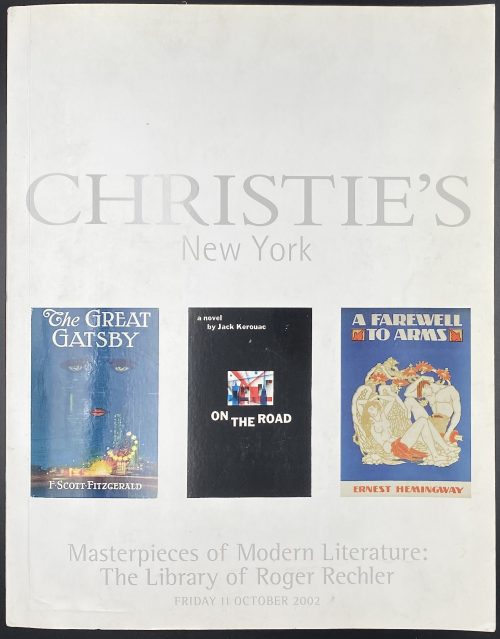 Publisher’s pictorial wrappers: CHRISTIE'S | NEW YORK | {three book covers} | Masterpieces of Modern Literature: | The Library of Roger Rechler | FRIDAY 11 OCTOBER 2002 || Red spine with white lettering from top to bottom, multiple illustrations in colour, 26.8 x 21 x 3 cm. Pagination: [1-4] 5-451 [452]. 375 lots, prices realized handwritten next to each lot and on 6 loose leaves inserted.
Publisher’s pictorial wrappers: CHRISTIE'S | NEW YORK | {three book covers} | Masterpieces of Modern Literature: | The Library of Roger Rechler | FRIDAY 11 OCTOBER 2002 || Red spine with white lettering from top to bottom, multiple illustrations in colour, 26.8 x 21 x 3 cm. Pagination: [1-4] 5-451 [452]. 375 lots, prices realized handwritten next to each lot and on 6 loose leaves inserted. -
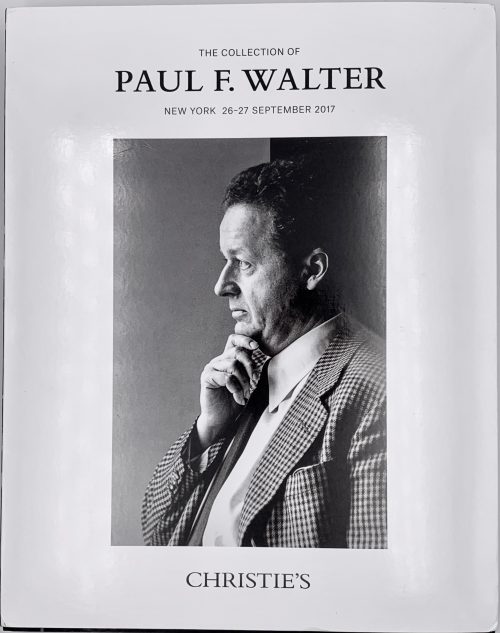 Christie's Auction Catalog; Sale WALTER-15785; New York, September 26-27, 2017; Publisher's pictorial wrappers, front cover: THE COLLECTION OF | PAUL F. WALTER | NEW YORK 26–27 SEPTEMBER 2917 | {profile chest portrait of Paul F. Walter} | CHRISTIE'S || 26.8 x 21.2 x 3 cm; 662 lots, illustrations in colour and b/w, pictorial dust jacket; pp: [2] 3-462.
Christie's Auction Catalog; Sale WALTER-15785; New York, September 26-27, 2017; Publisher's pictorial wrappers, front cover: THE COLLECTION OF | PAUL F. WALTER | NEW YORK 26–27 SEPTEMBER 2917 | {profile chest portrait of Paul F. Walter} | CHRISTIE'S || 26.8 x 21.2 x 3 cm; 662 lots, illustrations in colour and b/w, pictorial dust jacket; pp: [2] 3-462.Paul F. Walter (American, 1935 – 2017) – "Collector. Following studies in history and history of art Oberlin College, Ohio, and Columbia University, he began to collect in the1960s, starting with prints by Whistler and moving on to the Aesthetic Movement and the Arts & Crafts in Britain, as well as the arts of the Indian subcontinent and modern American painting. He was Trustee of the Museum of Modern Art from 1992-2006, and a benefactor to the Metropolitan Museum of Art, the Cooper-Hewitt Design Museum, the Morgan Library and Museum, the Brooklyn Museum, the Allen Memorial Art Museum at Oberlin College, and the Los Angeles County Museum of Art."
-
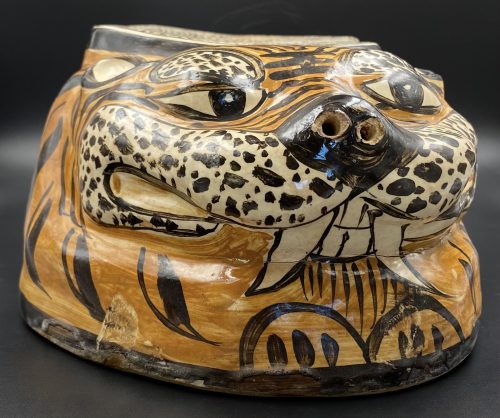 The pillow is moulded as a recumbent tiger, the details painted in dark brown and pale russet on a white slip and under a clear glaze, and the slightly dished top is painted with a winged beast. China, the Jin dynasty [金朝] (1115 – 1234). Dimensions: 12 x 34.5 x 19.5 cm
The pillow is moulded as a recumbent tiger, the details painted in dark brown and pale russet on a white slip and under a clear glaze, and the slightly dished top is painted with a winged beast. China, the Jin dynasty [金朝] (1115 – 1234). Dimensions: 12 x 34.5 x 19.5 cm -
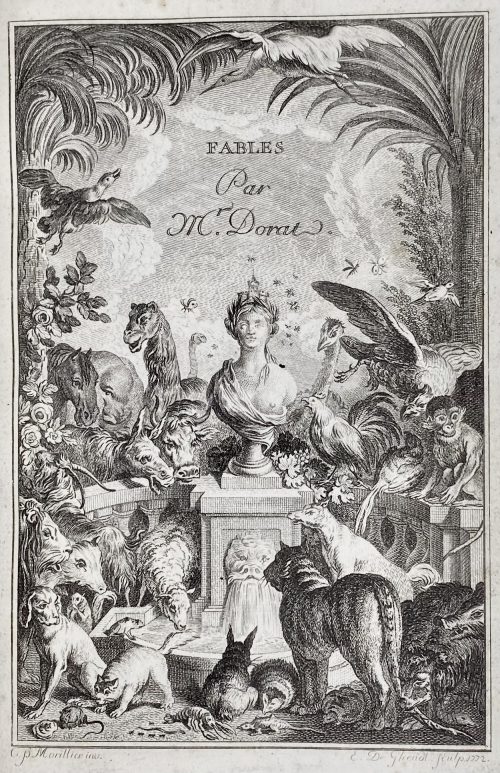 Title-page: FABLES | NOUVELLES. | {vignette by Ponce after Marillier} | A LA HAYE, | Et se trouve a Paris, | Chez Delalain, rue de la Comédie Françoise. | — | M. DCC. LXXIII. || Collation: 2 volumes (4 livres) in one, 1st blank, engraved t.p. “FABLES | Par | Mr. Dorat.” signed C. P. Marillier, inv. – E. D. Ghendt Sculp. 1772; a-c4, A-Z4 2A-2Q4, last blank, plus engraved frontispiece before A1 by Nicolas Delaunay and engraved d.t.p. before Z1: “Fables | de M. Dorat | II. Volume” also by Ghendt after Marillier., 99 vignettes and 99 tailpieces, all after Marillier. Lacking Delaunay frontispiece for the second volume (similar to the 1st). Edition: This is a vol. 1 176 pp. copy (Ray, 43). 2nd edition after Fables ou allégories philosophiques, 1772, p. 162 corrected: “Je sais , même au sein des poisons / Puiser le suc qui m'est utile”. Page xxii numbered correctly; on top of p. iii, printed a chain instead of a triple fillet in later issues (Ray, 43A). Pagination: [i, ii] iii-xxii, [2 d.t.p. «Livre premier»] [1] 2-309 [3 table], 3 plates. Binding: Crimson crashed morocco (198 x 133 mm) ruled in gilt, spine with raised bands gilt in compartments with gilt-lettered cream calf label, gilt dentelle inside, marbled endpapers, Pauli Menso bookplate pasted to front pastedown, printed on laid paper, AEG. Catalogue raisonné: Cohen-DeRicci: 313-315; Ray (French): № 43, pp. 81-83. Provenance: Pauli Menso. We only present a sample of illustrations, as their total number is enormous. Contributors: Author: Claude Joseph Dorat (French, 1734–1780) Publisher: Delalain (firm) (18th century) Artist: Clément Pierre Marillier (French, 1740–1808) Engravers: Jean Charles Baquoy (French, 1721–1777) Nicolas Delaunay (French, 1739–1792) Pierre Duflos (French, born in 1751) Emmanuel Jean Nepomucène de Ghendt (Flemish, worked in France, 1738–1815) Yves-Marie Le Gouaz (French, 1742–1816) Pierre Adrien Le Beau (French, 1748–after 1800) Jean-Jacques André Le Veau (French, 1729–1786) Charles Louis Lingée (French, 1748–1819) Joseph de Longueil (French, 1730–1792) Louis Legrand (French, 1723–1807) Jacques Le Roy (French, born in 1739) Louis Joseph Masquelier (French, 1741–1811) François Denis Née (French, 1735–1818) Nicholas Ponce (French, 1746–1831) Marguerite (Hémery) Ponce (French, born in 1745) Jean Baptiste Simonet (French, 1742–1813)
Title-page: FABLES | NOUVELLES. | {vignette by Ponce after Marillier} | A LA HAYE, | Et se trouve a Paris, | Chez Delalain, rue de la Comédie Françoise. | — | M. DCC. LXXIII. || Collation: 2 volumes (4 livres) in one, 1st blank, engraved t.p. “FABLES | Par | Mr. Dorat.” signed C. P. Marillier, inv. – E. D. Ghendt Sculp. 1772; a-c4, A-Z4 2A-2Q4, last blank, plus engraved frontispiece before A1 by Nicolas Delaunay and engraved d.t.p. before Z1: “Fables | de M. Dorat | II. Volume” also by Ghendt after Marillier., 99 vignettes and 99 tailpieces, all after Marillier. Lacking Delaunay frontispiece for the second volume (similar to the 1st). Edition: This is a vol. 1 176 pp. copy (Ray, 43). 2nd edition after Fables ou allégories philosophiques, 1772, p. 162 corrected: “Je sais , même au sein des poisons / Puiser le suc qui m'est utile”. Page xxii numbered correctly; on top of p. iii, printed a chain instead of a triple fillet in later issues (Ray, 43A). Pagination: [i, ii] iii-xxii, [2 d.t.p. «Livre premier»] [1] 2-309 [3 table], 3 plates. Binding: Crimson crashed morocco (198 x 133 mm) ruled in gilt, spine with raised bands gilt in compartments with gilt-lettered cream calf label, gilt dentelle inside, marbled endpapers, Pauli Menso bookplate pasted to front pastedown, printed on laid paper, AEG. Catalogue raisonné: Cohen-DeRicci: 313-315; Ray (French): № 43, pp. 81-83. Provenance: Pauli Menso. We only present a sample of illustrations, as their total number is enormous. Contributors: Author: Claude Joseph Dorat (French, 1734–1780) Publisher: Delalain (firm) (18th century) Artist: Clément Pierre Marillier (French, 1740–1808) Engravers: Jean Charles Baquoy (French, 1721–1777) Nicolas Delaunay (French, 1739–1792) Pierre Duflos (French, born in 1751) Emmanuel Jean Nepomucène de Ghendt (Flemish, worked in France, 1738–1815) Yves-Marie Le Gouaz (French, 1742–1816) Pierre Adrien Le Beau (French, 1748–after 1800) Jean-Jacques André Le Veau (French, 1729–1786) Charles Louis Lingée (French, 1748–1819) Joseph de Longueil (French, 1730–1792) Louis Legrand (French, 1723–1807) Jacques Le Roy (French, born in 1739) Louis Joseph Masquelier (French, 1741–1811) François Denis Née (French, 1735–1818) Nicholas Ponce (French, 1746–1831) Marguerite (Hémery) Ponce (French, born in 1745) Jean Baptiste Simonet (French, 1742–1813) -
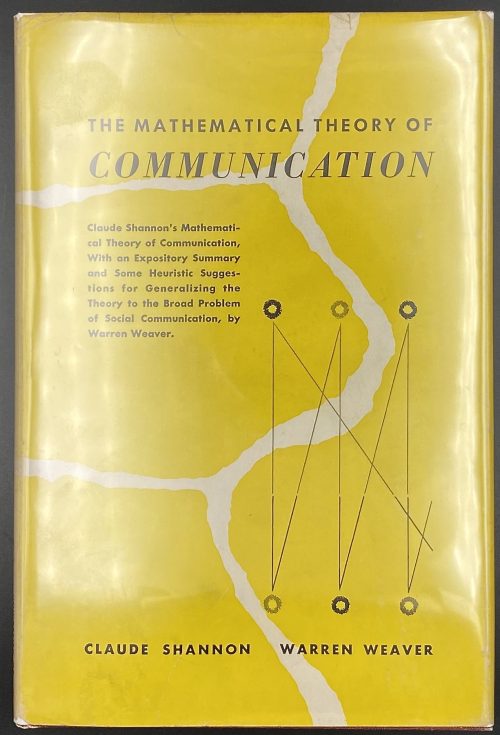 Title page: The Mathematical Theory | Of Communication | By CLAUDE E. SHANNON | and WARREN WEAVER | THE UNIVERSITY OF ILLINOIS PRESS: URBANA | 1949 || Pagination: [8] [2] 3-117 [3 blanks]. Size: 23.5 x 16 cm Binding: Publisher’s burgundy cloth, silver lettering to spine, yellow pictorial DJ with lettering: THE MATHEMATICAL THEORY OF | COMMUNICATION | {8 lines of text} {graph} | CLAUDE SHANNON WARREN WEAVER || Contributors: Shannon, Claude Elwood (American, 1916 – 2001) Weaver, Warren (American, 1894 – 1978)
Title page: The Mathematical Theory | Of Communication | By CLAUDE E. SHANNON | and WARREN WEAVER | THE UNIVERSITY OF ILLINOIS PRESS: URBANA | 1949 || Pagination: [8] [2] 3-117 [3 blanks]. Size: 23.5 x 16 cm Binding: Publisher’s burgundy cloth, silver lettering to spine, yellow pictorial DJ with lettering: THE MATHEMATICAL THEORY OF | COMMUNICATION | {8 lines of text} {graph} | CLAUDE SHANNON WARREN WEAVER || Contributors: Shannon, Claude Elwood (American, 1916 – 2001) Weaver, Warren (American, 1894 – 1978) -
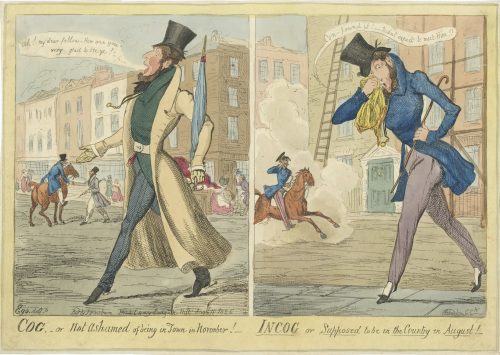 Description by British Museum (1865,1111.2128): "Two designs, side by side. [1] A dandy (probably a portrait), florid, whiskered, and bearded, steps jauntily from the pavement, hand extended, saying: Ah! my dear fellow — How are you? Devilish glad to see ye!— He holds a closed umbrella, ferrule erect, and wears a long tight-waisted coat to the heels, unbuttoned, tight pantaloons and spurred boots. In the middle distance, another dandy grasps the hand of a friend on horseback. Behind are houses with shop-fronts. A man raises his hat to a lady who curtseys. [2] The same dandy steps from the roadway onto the pavement, his handkerchief to his nose; he stoops, trying to conceal himself from a dandy cantering past in a cloud of dust, his eye-glass to his eye. He is without gloves, extraordinary for a dandy, and his trousers are strapped over pumps; he says: Con-found it! — Didn't expect to meet Him!! The street is otherwise empty; against the (large) houses are scaffolding and a tall ladder." Lettered with title, text within image including production details: 'Ego. delt / Etched by G. Ck / Pubd by J Fairburn Broadway Ludgate Hill August 18 1826'. Dimensions: Sheet: 25.5 x 36 cm, Image: 21.7 x 33.8 cm. Catalogue raisonné: A. M. Cohn (1924): № 1001, p. 262.: "A wretched plate. Difficult to believe G. C. had anything to do with it." — Bruton. Value.— £1.
Description by British Museum (1865,1111.2128): "Two designs, side by side. [1] A dandy (probably a portrait), florid, whiskered, and bearded, steps jauntily from the pavement, hand extended, saying: Ah! my dear fellow — How are you? Devilish glad to see ye!— He holds a closed umbrella, ferrule erect, and wears a long tight-waisted coat to the heels, unbuttoned, tight pantaloons and spurred boots. In the middle distance, another dandy grasps the hand of a friend on horseback. Behind are houses with shop-fronts. A man raises his hat to a lady who curtseys. [2] The same dandy steps from the roadway onto the pavement, his handkerchief to his nose; he stoops, trying to conceal himself from a dandy cantering past in a cloud of dust, his eye-glass to his eye. He is without gloves, extraordinary for a dandy, and his trousers are strapped over pumps; he says: Con-found it! — Didn't expect to meet Him!! The street is otherwise empty; against the (large) houses are scaffolding and a tall ladder." Lettered with title, text within image including production details: 'Ego. delt / Etched by G. Ck / Pubd by J Fairburn Broadway Ludgate Hill August 18 1826'. Dimensions: Sheet: 25.5 x 36 cm, Image: 21.7 x 33.8 cm. Catalogue raisonné: A. M. Cohn (1924): № 1001, p. 262.: "A wretched plate. Difficult to believe G. C. had anything to do with it." — Bruton. Value.— £1. -
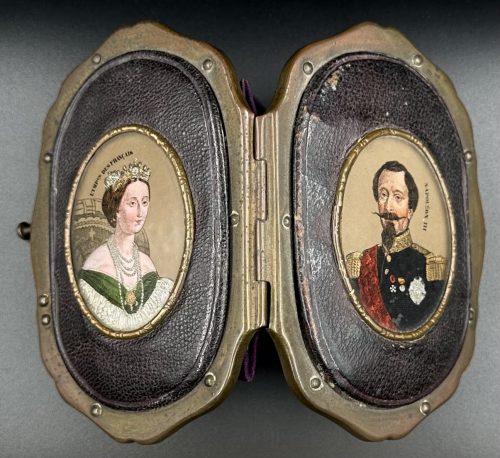 Coin purse, or porte-monnaie, made of patinated copper alloy, full-grain brown leather outside and purple inside, with a clutch and a hinge, and an oval miniature bust portrait on each side, painted in colour with gold and silver, by an anonymous artist after Franz Xaver Winterhalter, inscribed NAPOLÉON III and L'IMPCE DES FRANÇAIS, respectively, under glass. Dimensions: 97 x 67 x 18 mm. Contributors: Napoleon III [Charles Louis Napoléon Bonaparte] (French, 1808 – 1873) – character/sitter. Eugénie de Montijo [María Eugenia Ignacia Agustina de Palafox y Kirkpatrick] (Spanish-French, 1826 – 1920) – character/sitter. Franz Xaver Winterhalter (German, 1805 – 1873) – artist.
Coin purse, or porte-monnaie, made of patinated copper alloy, full-grain brown leather outside and purple inside, with a clutch and a hinge, and an oval miniature bust portrait on each side, painted in colour with gold and silver, by an anonymous artist after Franz Xaver Winterhalter, inscribed NAPOLÉON III and L'IMPCE DES FRANÇAIS, respectively, under glass. Dimensions: 97 x 67 x 18 mm. Contributors: Napoleon III [Charles Louis Napoléon Bonaparte] (French, 1808 – 1873) – character/sitter. Eugénie de Montijo [María Eugenia Ignacia Agustina de Palafox y Kirkpatrick] (Spanish-French, 1826 – 1920) – character/sitter. Franz Xaver Winterhalter (German, 1805 – 1873) – artist.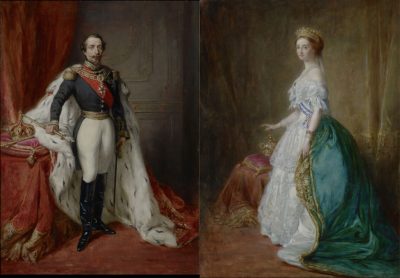
-
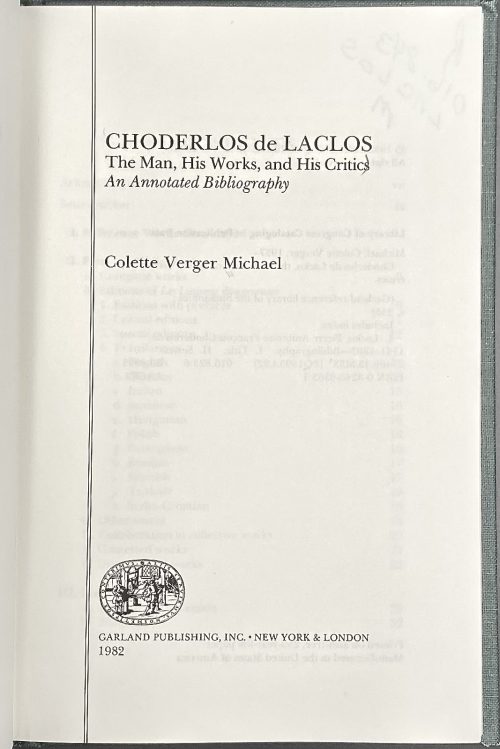 One volume 22.3 x 14.4 cm, green buckram, gilt lettering to spine, Brooklyn public library copy with stamps and sticker; [i-iv] v-xi [xii blank], [1-2] 3-144 [4 blank], total 160 pages, 80 leaves; 620 entries + index. Title-page (vertical double-rule, left indent): CHODERLOS de LACLOS | The Man, His Works, and His Critics | An Annotated Bibliography | Colette Verger Michael | {publisher’s device} | GARLAND PUBLISHING INC. • NEW YORK & LONDON | 1982 || Contributors: Michael, Colette Verger (American, b. 1937) Choderlos de Laclos, Pierre Ambroise François (French, 1741 – 1803) – author. Ref.: WorldCat.
One volume 22.3 x 14.4 cm, green buckram, gilt lettering to spine, Brooklyn public library copy with stamps and sticker; [i-iv] v-xi [xii blank], [1-2] 3-144 [4 blank], total 160 pages, 80 leaves; 620 entries + index. Title-page (vertical double-rule, left indent): CHODERLOS de LACLOS | The Man, His Works, and His Critics | An Annotated Bibliography | Colette Verger Michael | {publisher’s device} | GARLAND PUBLISHING INC. • NEW YORK & LONDON | 1982 || Contributors: Michael, Colette Verger (American, b. 1937) Choderlos de Laclos, Pierre Ambroise François (French, 1741 – 1803) – author. Ref.: WorldCat. -
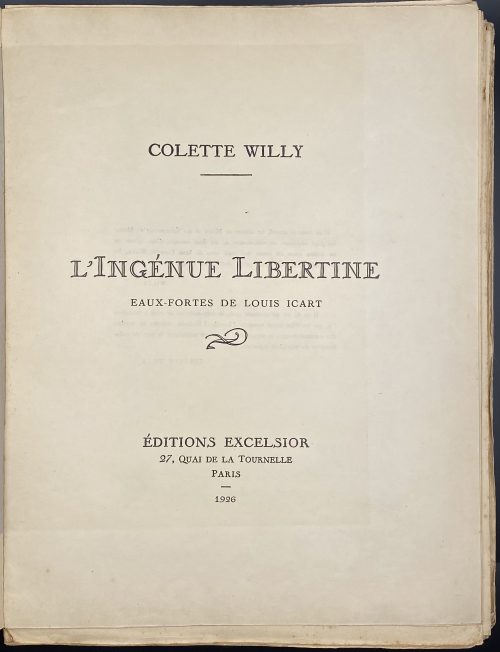 Title-page: COLETTE WILLY | — | L'ingénue libertine | EAUX-FORTES DE LOUIS ICART | ❧ | ÉDITIONS EXCELSIOR | 27, Quai de la Tournelle | Paris | 1926 || Description: French cream flapped wrappers 33.5 x 26 cm with gilt lettering to front and spine, printed on wove paper (Japon Impérial), [2] blank, [1-4] h.t. / limitation, t.p. / citations, 5-191 [3] colophon, plus 20 plates of coloured etchings and 20 plates of b/w etchings, incl. frontispiece. Edition enriched with an autograph letter signed by Colette tipped in after limitation. Edition: limited to 546 copies of which one (№ UN) is unique, printed on Papier de Chine with original colour drawings, 55 (№ 1-50 + 5 H.C.) on Japon Impérial, 65 (№ 51-100 +15 H.C.) on Hollande van Gelder, and 425 (№ 101-500 + 25 H.C.) on vergé paper BFK Rives. This copy is № 48, enriched with Colette a.l.s. and an extra suite of plates. Printed on December 3, 1926, at Arrault et Cie in Tours. Transcript of a.l.s.: "De deux romans (Minne et Les égarements de Minne) qui ne portèrent pas ma signature, j’en ai fait un seul : l’Ingénue libertine. La première partie trouve encore grâce à mes yeux ; je suis plus sévère pour la deuxième et dernière, [mot rayé] superflue et qui sent le travail. Cette libertine aurait bien dû en rester à l’ingénuité. — Colette" Contributors: Sidonie-Gabrielle Colette [a.k.a. Colette] (French, 1873 – 1954) – author. Henry Gauthier-Villars [a.k.a. Willy] (French, 1859 – 1931) – author. Louis Icart (French, 1888 – 1950) – artist.
Title-page: COLETTE WILLY | — | L'ingénue libertine | EAUX-FORTES DE LOUIS ICART | ❧ | ÉDITIONS EXCELSIOR | 27, Quai de la Tournelle | Paris | 1926 || Description: French cream flapped wrappers 33.5 x 26 cm with gilt lettering to front and spine, printed on wove paper (Japon Impérial), [2] blank, [1-4] h.t. / limitation, t.p. / citations, 5-191 [3] colophon, plus 20 plates of coloured etchings and 20 plates of b/w etchings, incl. frontispiece. Edition enriched with an autograph letter signed by Colette tipped in after limitation. Edition: limited to 546 copies of which one (№ UN) is unique, printed on Papier de Chine with original colour drawings, 55 (№ 1-50 + 5 H.C.) on Japon Impérial, 65 (№ 51-100 +15 H.C.) on Hollande van Gelder, and 425 (№ 101-500 + 25 H.C.) on vergé paper BFK Rives. This copy is № 48, enriched with Colette a.l.s. and an extra suite of plates. Printed on December 3, 1926, at Arrault et Cie in Tours. Transcript of a.l.s.: "De deux romans (Minne et Les égarements de Minne) qui ne portèrent pas ma signature, j’en ai fait un seul : l’Ingénue libertine. La première partie trouve encore grâce à mes yeux ; je suis plus sévère pour la deuxième et dernière, [mot rayé] superflue et qui sent le travail. Cette libertine aurait bien dû en rester à l’ingénuité. — Colette" Contributors: Sidonie-Gabrielle Colette [a.k.a. Colette] (French, 1873 – 1954) – author. Henry Gauthier-Villars [a.k.a. Willy] (French, 1859 – 1931) – author. Louis Icart (French, 1888 – 1950) – artist. -
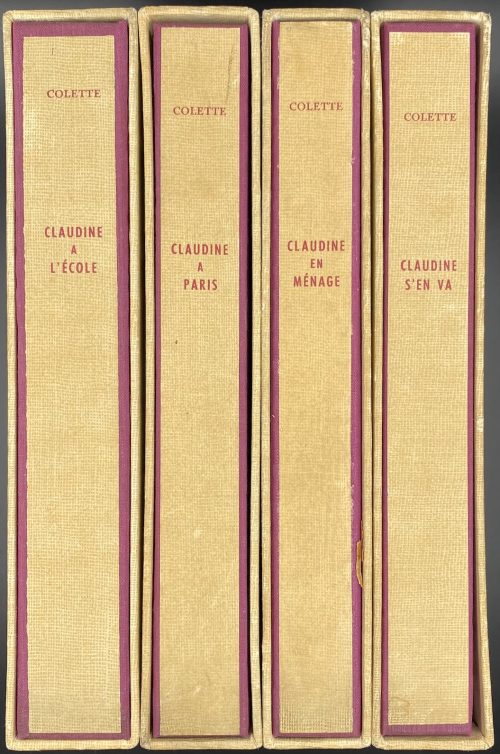 (1) Claudine à l'école: 1st blank and limitation leaves uncut, t.p. / blank ; [1-6] 7-206 [2], colophon "IMPRIMÉ EN BELGIQUE"; 208 pages (104 leaves) plus 12 plates. COLETTE | Claudine | {vignette} | à l'école | ILLUSTRÉE PAR | RENÉE RINGEL | « Leurs Chefs-d'œuvre » | AUX ÉDITIONS TERRES LATINES || (2) Claudine à Paris: 1st blank and limitation leaves uncut, t.p. / blank ; [1-6] 7-153 [3], colophon "IMPRIMÉ EN BELGIQUE"; 156 pages (78 leaves) plus 12 plates. COLETTE | Claudine | {vignette} | à Paris | ILLUSTRÉE PAR | RENÉE RINGEL | « Leurs Chefs-d'œuvre » | AUX ÉDITIONS TERRES LATINES || (3) Claudine en ménage: 1st blank and limitation leaves uncut, t.p. / blank ; [1-6] 7-150 [2], colophon "IMPRIMÉ EN BELGIQUE"; 152 pages (76 leaves) plus 12 plates. COLETTE | Claudine | {vignette} | en ménage | ILLUSTRÉE PAR | RENÉE RINGEL | « Leurs Chefs-d'œuvre » | AUX ÉDITIONS TERRES LATINES || (4) Claudine s'en va: 1st blank and limitation leaves uncut, t.p. / blank ; [1-6] 7-128 [4], colophon "IMPRIMÉ EN BELGIQUE"; 132 pages (66 leaves) plus 12 plates. COLETTE | Claudine | {vignette} | s'en va | ILLUSTRÉE PAR | RENÉE RINGEL | « Leurs Chefs-d'œuvre » | AUX ÉDITIONS TERRES LATINES || Illustrations: in each volume, there are 12 plates extraneous to collation, incl. frontispiece, stencil-coloured (au pochoir) collotype reproductions after drawings by Renée Ringel, and numerous in-text b/w illustrations. Binding: 4 volumes uniformly bound in French flapped pictorial wrappers, spine with lettering and vignette, each in a canvas double slipcase 22 x 17.5 cm, with lettering to spine. Edition: Limited to 1800 copies, of which this is copy № 365, printed by Jean de Clercq, plates printed by Thill, colouring by Ateliers du coloris d’art. Contributors: Sidonie-Gabrielle Colette [a.k.a. Colette] (French, 1873 – 1954) Renée Ringel – nothing is known so far.
(1) Claudine à l'école: 1st blank and limitation leaves uncut, t.p. / blank ; [1-6] 7-206 [2], colophon "IMPRIMÉ EN BELGIQUE"; 208 pages (104 leaves) plus 12 plates. COLETTE | Claudine | {vignette} | à l'école | ILLUSTRÉE PAR | RENÉE RINGEL | « Leurs Chefs-d'œuvre » | AUX ÉDITIONS TERRES LATINES || (2) Claudine à Paris: 1st blank and limitation leaves uncut, t.p. / blank ; [1-6] 7-153 [3], colophon "IMPRIMÉ EN BELGIQUE"; 156 pages (78 leaves) plus 12 plates. COLETTE | Claudine | {vignette} | à Paris | ILLUSTRÉE PAR | RENÉE RINGEL | « Leurs Chefs-d'œuvre » | AUX ÉDITIONS TERRES LATINES || (3) Claudine en ménage: 1st blank and limitation leaves uncut, t.p. / blank ; [1-6] 7-150 [2], colophon "IMPRIMÉ EN BELGIQUE"; 152 pages (76 leaves) plus 12 plates. COLETTE | Claudine | {vignette} | en ménage | ILLUSTRÉE PAR | RENÉE RINGEL | « Leurs Chefs-d'œuvre » | AUX ÉDITIONS TERRES LATINES || (4) Claudine s'en va: 1st blank and limitation leaves uncut, t.p. / blank ; [1-6] 7-128 [4], colophon "IMPRIMÉ EN BELGIQUE"; 132 pages (66 leaves) plus 12 plates. COLETTE | Claudine | {vignette} | s'en va | ILLUSTRÉE PAR | RENÉE RINGEL | « Leurs Chefs-d'œuvre » | AUX ÉDITIONS TERRES LATINES || Illustrations: in each volume, there are 12 plates extraneous to collation, incl. frontispiece, stencil-coloured (au pochoir) collotype reproductions after drawings by Renée Ringel, and numerous in-text b/w illustrations. Binding: 4 volumes uniformly bound in French flapped pictorial wrappers, spine with lettering and vignette, each in a canvas double slipcase 22 x 17.5 cm, with lettering to spine. Edition: Limited to 1800 copies, of which this is copy № 365, printed by Jean de Clercq, plates printed by Thill, colouring by Ateliers du coloris d’art. Contributors: Sidonie-Gabrielle Colette [a.k.a. Colette] (French, 1873 – 1954) Renée Ringel – nothing is known so far. -
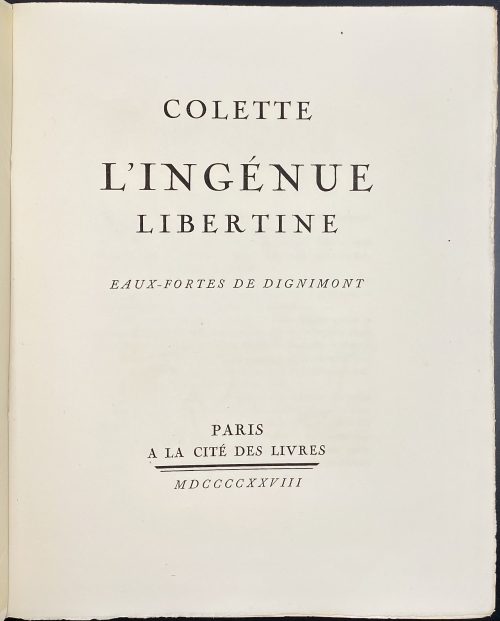 Title-page: COLETTE | L'INGÉNUE | LIBERTINE | EAUX-FORTES DE DIGNIMONT | PARIS | A LA CITÉ DES LIVRES | — | MDCCCCXXVIII || Cover (front wrapper): Similar to t.p. but in red and black: COLETTE | L'INGÉNUE | LIBERTINE | EAUX-FORTES DE DIGNIMONT | PARIS | A LA CITÉ DES LIVRES | — | MDCCCCXXVIII || Description: French flapped wrapper in a red marbled double slipcase with lettered paper label to spine, 29.5 x 23 x 5.5 cm, in-4to, leaves 28 x 22.5 cm. Collation: π4 (π1 in wrapper, π2 blank, π3 h.t. / limitation, π4 t.p. / blank, 1-304, χ2 (χ1 blank, χ2 in wrapper), plus 15 plates extraneous to collation, with tissue-guards, incl. frontispiece. Pagination: [8] [1] 2-237 [238] [6], ils. Plates: 15 etchings in sepia by André Dignimont. Enrichment: Additional full suite of 15 plates in sanguine. Limitation: Edition is limited to 215 copies, 150 of them printed on thick wove paper (Vélin de Hollande), numbered 41 – 190, with one additional suite of plates. This copy is № 168. Printed on October 14, 1928. Contributors: Sidonie-Gabrielle Colette [a.k.a. Colette] (French, 1873 – 1954) André Dignimont (French, 1891 – 1965) – artist. La cité des livres – publishers. R. Coulouma (Argenteuil, director H. Barthélemy) – printer, typography. Atelier de la Roseraie – printer, etchings.
Title-page: COLETTE | L'INGÉNUE | LIBERTINE | EAUX-FORTES DE DIGNIMONT | PARIS | A LA CITÉ DES LIVRES | — | MDCCCCXXVIII || Cover (front wrapper): Similar to t.p. but in red and black: COLETTE | L'INGÉNUE | LIBERTINE | EAUX-FORTES DE DIGNIMONT | PARIS | A LA CITÉ DES LIVRES | — | MDCCCCXXVIII || Description: French flapped wrapper in a red marbled double slipcase with lettered paper label to spine, 29.5 x 23 x 5.5 cm, in-4to, leaves 28 x 22.5 cm. Collation: π4 (π1 in wrapper, π2 blank, π3 h.t. / limitation, π4 t.p. / blank, 1-304, χ2 (χ1 blank, χ2 in wrapper), plus 15 plates extraneous to collation, with tissue-guards, incl. frontispiece. Pagination: [8] [1] 2-237 [238] [6], ils. Plates: 15 etchings in sepia by André Dignimont. Enrichment: Additional full suite of 15 plates in sanguine. Limitation: Edition is limited to 215 copies, 150 of them printed on thick wove paper (Vélin de Hollande), numbered 41 – 190, with one additional suite of plates. This copy is № 168. Printed on October 14, 1928. Contributors: Sidonie-Gabrielle Colette [a.k.a. Colette] (French, 1873 – 1954) André Dignimont (French, 1891 – 1965) – artist. La cité des livres – publishers. R. Coulouma (Argenteuil, director H. Barthélemy) – printer, typography. Atelier de la Roseraie – printer, etchings.


